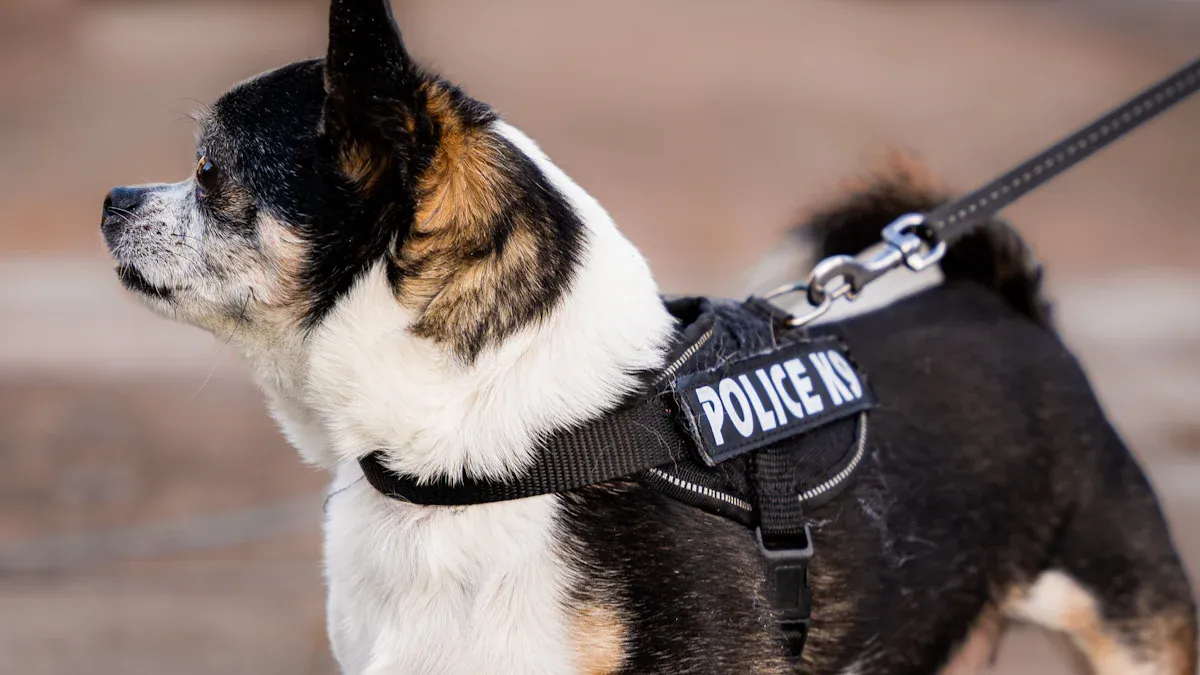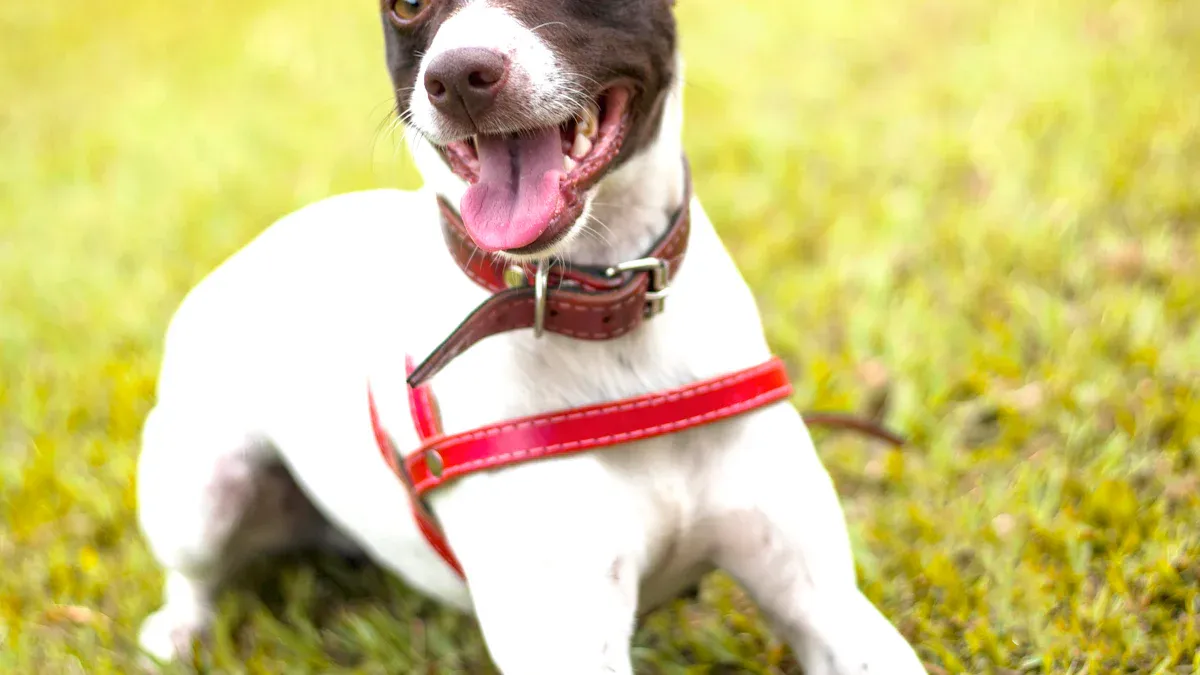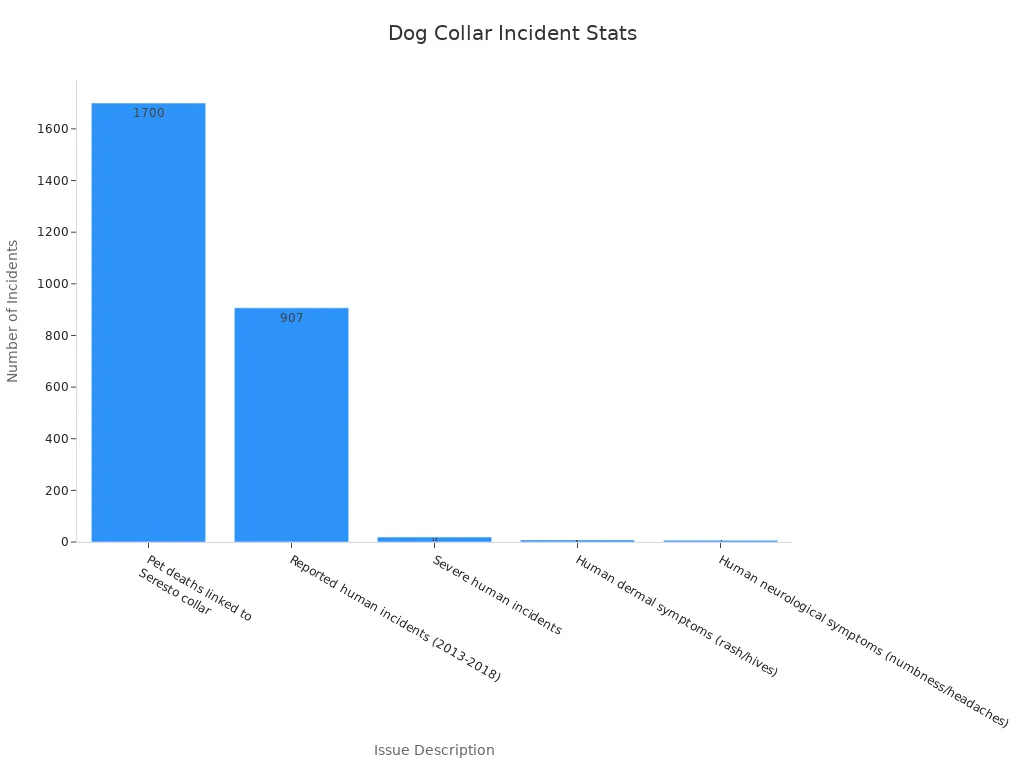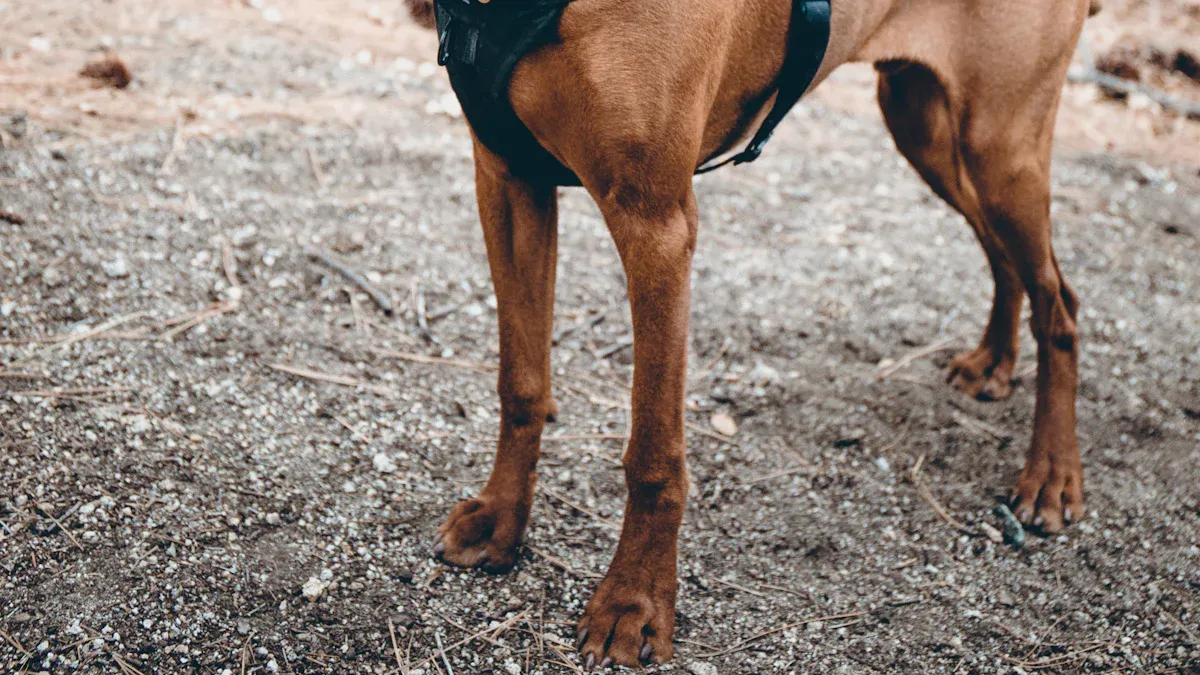Dog Harness vs Collar Pros and Cons Explained

Choosing between a dog harness vs collar for your pet can be tricky. Your dog's comfort and safety are very important. Both options have their pros and cons. The best choice depends on what your dog needs. Some dogs require the control of a harness, while others do better with a simple collar. Factors like breed, size, health, and behavior play a significant role. Understanding these differences helps you select the best option for your furry friend.
Key Takeaways
-
Pick a dog harness for more control and safety. It’s great for dogs that pull or have health problems.
-
Dog collars are simple to use and look nice. They work well for trained dogs that don’t pull on the leash.
-
Think about your dog’s breed and size when choosing. This helps avoid injuries with either a collar or harness.
-
Always focus on comfort and fit. A good-fitting harness or collar keeps your dog safe and comfortable.
-
Using both a collar and harness can help with ID and control. This keeps your dog safe during walks.
Pros and Cons of Dog Collars

Benefits of Dog Collars
Dog collars are a popular choice for many pet owners. They have several benefits that make them useful and easy to use. Here are some reasons to choose a dog collar:
-
Ease of Use: Collars are simple to put on or take off. This makes them great for quick walks or when you’re in a hurry.
-
Minimalist Design: They are lightweight and keep your dog comfy all day.
-
Cost-Effective: Collars are cheaper than harnesses, making them budget-friendly.
-
Stylish Options: Collars come in many designs, from bright colors to reflective styles.
-
ID Tag Attachment: You can attach ID tags to collars, which helps keep your dog safe.
-
Ideal for Trained Dogs: If your dog doesn’t pull on the leash, a collar works well.
Tip: A reflective collar, like the 3M reflective training collar, helps your dog stay visible during night walks.
Here’s a simple table comparing the pros and cons of dog collars:
|
Cons of Dog Collars |
|
|---|---|
|
Easy to use |
Can hurt dogs that pull on leashes |
|
Lightweight and comfortable |
Doesn’t give much control for guiding your dog |
|
Stylish designs available |
Breakaway collars might detach at bad times |
|
Affordable |
N/A |
|
Holds ID tags securely |
N/A |
|
Great for trained dogs |
N/A |
Drawbacks of Dog Collars
While collars are helpful, they also have some downsides. Think about these issues before deciding if a collar is right for your dog:
-
Risk of Injury: Dogs that pull on leashes can hurt their necks with collars.
-
Limited Control: Collars don’t give as much control as harnesses, especially for big or active dogs.
-
Breakaway Collars: These collars are made for safety but can come off unexpectedly.
-
Health Concerns: Some collars, like prong collars, can hurt your dog and cause stress. As one expert says:
“Prong collars cause pain and harm a dog’s emotional health. That’s why they work.”
Some collars have even been linked to serious health problems. For example, a study showed shocking numbers about pet deaths and human health issues caused by certain collars:

-
Nearly 1,700 pets died because of Seresto collars.
-
Over 900 human problems were reported from 2013 to 2018, including rashes, headaches, and seizures.
These facts show how important it is to pick a collar that keeps your dog safe and healthy.
Note: If your dog pulls a lot or has neck problems, a harness might be a better choice. This is especially true when comparing a collar vs harness for dogs with special needs.
Pros and Cons of Dog Harnesses

Advantages of Dog Harnesses
Dog harnesses have many benefits that make them a smart choice. If your dog pulls on the leash or has health issues, a harness can be safer and more comfortable. Here’s why:
-
Better Control: Harnesses give you more control during walks or training. They are helpful for dogs that pull or lunge a lot.
-
Safety First: Harnesses spread pressure across the chest and shoulders. This lowers the chance of injury, especially for small or older dogs.
-
Comfortable Fit: A good harness keeps your dog comfy on walks. Many have soft padding and adjustable straps for a snug fit.
-
Training Aid: Training harnesses help teach dogs to walk nicely. They stop pulling and make guiding your dog easier.
-
Vehicle Safety: Some harnesses are crash-tested for car rides. They act like seatbelts, keeping your dog safe during sudden stops.
Tip: Think about your dog’s needs when picking a harness. For night walks, a reflective LED harness can keep your dog visible.
Here’s a simple comparison of collars vs harnesses based on key features:
|
Feature |
Dog Collar |
Dog Harness |
|---|---|---|
|
Convenience |
Easy to put on and take off |
Can be harder to use |
|
Safety |
May hurt neck if dog pulls |
Spreads pressure, safer for dogs |
|
Training |
Not great for pullers |
Helps train dogs to stop pulling |
|
Comfort |
Can feel tight or uncomfortable |
More comfy if fitted correctly |
|
ID Tag |
Has space for ID tag |
Some may not have a spot for ID tags |
|
Fit |
Needs proper fit to avoid slipping |
Must fit well to prevent discomfort |
Disadvantages of Dog Harnesses
Harnesses are great but not perfect for every dog. Some downsides might make you think twice depending on your dog’s needs.
-
Less Convenient: Harnesses can be harder to put on, especially with fidgety dogs. Step-in harnesses are easier but still take time.
-
Bulky Design: Harnesses are bigger than collars and may feel heavy. Lightweight designs, like step-in harnesses, can help fix this.
-
Limited ID Tag Space: Some harnesses don’t have a spot for ID tags. You’ll need another way to show your dog’s identification.
-
Fit Challenges: A harness must fit just right to work well. Too tight, and it can rub. Too loose, and it won’t stay secure.
Note: Picking a harness with adjustable straps and soft padding is key. This ensures your dog stays comfortable and safe.
Harnesses are also important for car safety. Crash-tested harnesses spread force across the chest, lowering injury risks in sudden stops. Keeping your dog restrained in the car isn’t just safer—it can also help you avoid fines.
Pro Tip: If your dog pulls a lot, try a no-pull harness. It makes walks easier and helps with training.
Collar vs Harness: Things to Think About
Breed and Size Matter
Your dog’s breed and size are key when choosing between a collar or harness. Dogs with long necks can get hurt using collars. A harness is safer for them since it avoids neck pressure. Small dogs also do better with harnesses because they can easily hurt their throats. Flat-faced dogs, like pugs, often have trouble breathing. A harness helps by keeping pressure off their airways during walks.
Here’s a simple chart to guide your choice:
|
Breed Type |
Best Option |
Why It’s Better |
|---|---|---|
|
Long Necked Breeds |
Harness |
Protects their delicate necks from injuries. |
|
Small Breeds |
Harness |
Prevents throat injuries, safer than collars. |
|
Flat-Faced Breeds |
Harness |
Reduces airway pressure, makes breathing easier. |
Make sure the harness or collar fits well—not too tight or loose. A bad fit can make walks uncomfortable or even painful for your dog.
Health and Medical Needs
If your dog has health problems, picking the right gear is crucial. Collars can harm the throat, especially for dogs with neck or breathing issues. Harnesses spread pressure across the chest, making them safer for dogs with these conditions. But there isn’t much research on how collars or harnesses affect dogs with medical problems. Always ask your vet for advice before deciding.
For dogs with mobility issues or recovering from injuries, harnesses offer better support. Some even have handles to help you guide your dog during walks or stairs.
Training and Behavior
Does your dog pull or jump while on a leash? If yes, a harness is better for training. It gives you more control and protects your dog’s neck. No-pull harnesses are great for teaching leash manners. They stop pulling by gently guiding your dog without causing pain.
If your dog is already trained and doesn’t pull, a collar might be fine. Collars are light and easy for daily use. But for puppies or dogs still learning, a harness is safer and more effective.
Tip: Always pick gear that keeps your dog safe and comfy. The best choice depends on what your dog needs most.
Activity Level and Lifestyle
Your dog’s energy and daily habits matter when choosing gear. Active dogs who love running, hiking, or playing often do better with a harness. Harnesses give more control and lower the chance of injuries. A no-pull harness can also help manage excitement safely.
For calmer dogs, a collar might work well. Collars are light and easy for everyday use. If your dog takes short walks or stays indoors, a collar is simple and comfy. Always think about what keeps your dog safe and happy.
Your lifestyle matters too. Do you like outdoor adventures with your dog? If yes, pick a harness with reflective strips or lights for night walks. If you prefer quick walks nearby, a basic collar may be enough.
Trained dogs that don’t pull can wear collars comfortably. But if your dog pulls or has lots of energy, a harness is better. It gives you control and protects their neck from strain.
In the end, choose gear that fits your dog’s activity level and your routine. The right choice keeps your dog safe, comfy, and happy.
Types of Dog Collars and Harnesses
Popular Types of Dog Collars
Dog collars come in different styles for various needs. Picking the right one depends on your dog’s behavior and comfort. Here are some common types:
-
Regular (Flat) Collars: These are simple and adjustable for daily use. They’re great for attaching ID tags or trackers.
-
Martingale Collars: These tighten slightly when pulled but don’t choke. They’re ideal for dogs with narrow heads, like greyhounds.
-
Head Collars: These help train dogs to stop pulling or lunging. They gently guide your dog’s head during walks.
-
Rolled Collars: Made for dogs with sensitive skin, these prevent irritation and hair damage.
Note: Avoid chain slip or prong collars. They can hurt your dog and cause emotional stress.
Here’s a quick overview of dog collar trends:
|
Feature |
Description |
|---|---|
|
Market Size |
Expected to grow to USD 48.5 Billion by 2034 |
|
Innovations |
Smart collars with GPS, health tracking, and LED lights are popular. |
|
Consumer Preferences |
People want durable, comfy, and stylish collars. |
|
Customization |
Personalized collars with engravings and adjustable features are in demand. |
|
Training Products |
Includes collars for training and safe walking. |
Common Types of Dog Harnesses
Dog harnesses are a great option, especially for dogs that pull or have health issues. Here are some popular types:
-
No-Pull Harnesses: These have a front leash clip to stop pulling. They’re perfect for training and daily walks.
-
Step-In Harnesses: Easy to use, these are great for small or medium dogs. They’re lightweight and comfy for everyday use.
-
LED Smart Harnesses: These have lights and reflective strips for night walks. Some even include GPS tracker slots.
-
Bio-Based Harnesses: Made from eco-friendly materials, these are sustainable and easy to clean. They’re perfect for eco-conscious owners.
Studies show harnesses spread pressure across the chest, lowering injury risks. They’re safer for dogs with neck or breathing problems. However, some harnesses may limit shoulder movement in working dogs. Always pick a harness that fits well and matches your dog’s activity level.
|
Evidence Type |
Description |
|---|---|
|
Design or Style |
|
|
Stress-Related Behaviors |
Pressure spread reduces injury risk compared to collars. |
|
Kinematics |
Harnesses don’t change natural walking movements. |
Pro Tip: For active dogs, choose a harness with reflective strips or LED lights. It keeps them safe during outdoor activities.
Deciding between a dog collar or harness depends on your dog's needs. Collars are simple and good for trained dogs. Harnesses are safer and give more control for pullers or dogs with health issues.
Here’s a quick table to guide your choice:
|
Feature |
Dog Collars |
Dog Harnesses |
|---|---|---|
|
Control |
Best for calm, trained dogs |
Great for dogs that pull |
|
Comfort |
Can strain the throat |
Spreads pressure for better comfort |
|
Suitability |
Works for most dogs |
Ideal for dogs with breathing or neck problems |
|
Injury Prevention |
Less protective |
Helps prevent throat and back injuries |
Tip: Always choose what keeps your dog safe and comfy. A happy dog is a healthy dog.
FAQ
What’s the main difference between a dog harness and a collar?
A collar sits around your dog’s neck, while a harness wraps around their chest and shoulders. Harnesses offer better control and safety for dogs that pull. Collars are lightweight and ideal for trained dogs. Choosing between a dog harness vs collar depends on your dog’s needs.
Is a harness better for small dogs?
Yes, harnesses are safer for small dogs. They prevent throat injuries by spreading pressure across the chest. Collars can strain their necks, especially if they pull. For small breeds, a harness is usually the better choice.
Can I use both a harness and a collar?
Absolutely! Many pet owners use both. A collar holds ID tags, while a harness provides control during walks. Using both ensures safety and identification. It’s a great option when deciding between a dog harness vs collar.
Are harnesses harder to put on than collars?
Harnesses can take a little more time to put on, especially for fidgety dogs. Step-in harnesses are easier to use. Collars are quicker, but harnesses offer more safety and control, making them worth the effort.
Which is better for training: a harness or a collar?
Harnesses are better for training dogs that pull or jump. They give you control without straining the neck. No-pull harnesses are especially helpful for teaching leash manners. For trained dogs, collars work fine for everyday use.
See Also
Is It Harmful For My Dog To Wear A Harness All Day?
Key Advantages Of Gabby Whale's Reflective Dog Leash
Bear Pet Bowl Or Classic Dog Bowls: Which Is Superior?








